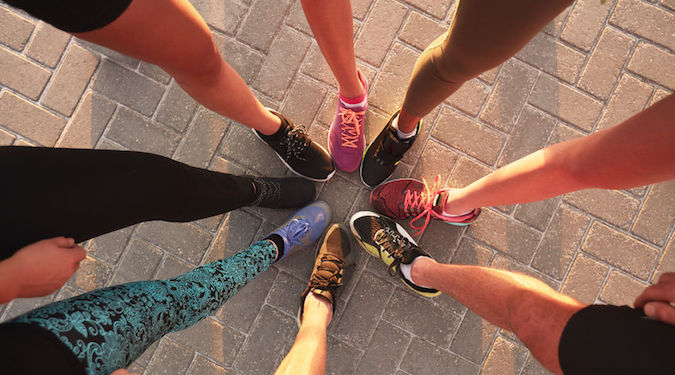Stand out but fit in – finding the balance your customers want in products and design
Share

Customers want products that make them feel autonomous yet connected. Dr Janneke Blijlevens explores how brands can find the balance.
It’s all about social balance. And no, I am not talking about party animals needing a quiet night in every once in a while, but about the product designs that attract us.
New research shows that consumers find product designs most beautiful when they help them feel like they fit in with their in-crowd, while simultaneously making them feel like a unique individual. As consumers, we aim to strike the perfect balance between these goals depending on our social situation or product type.
Whether it’s sunglasses, sneakers, backpacks, or even staplers, consumers treat product designs as social symbols. We use product designs to say something about ourselves to others. With the right designs, you can come across as professional, quirky or laid-back. As consumers, we all have a certain image of ourselves whether we know it or not. These are deeply held beliefs about the type of person we are, and the types of people that we belong to or to whom we’re similar – our in-crowd.
Without being completely aware, we will favour designs that help us communicate this image of ourselves to others.
Don’t believe me? Just take a look at your smartphone cover, bag or sunglasses and ask what they say about you.
Autonomous yet connected
Of course, we know what’s in fashion and what visual designs the products our in-crowd typically appreciates have. For example, a UX designer may own and display (at their local café) a sleek, thin, and stylish looking drawing tablet. We can all probably quite accurately describe the stereotypical design styles that represent inhabitants of our cities’ suburbs.
By choosing those sunglasses or sneakers that resemble the visual image of our in-groups, we can feel like we fit in. Fitting in makes us feel safe and comfortable in a socially complex and sometimes judgmental world.
From an evolutionary point of view, the desire to form and maintain social bonds has survival and reproductive benefits. In groups we can share food, provide mates, and help care for our offspring. The motivation behind choosing products to ‘fit in’ has deep roots.
When it comes to evolution, though, it is also important to stand out. People who succeed in standing positively gain status, achieve greater interpersonal influence, accrue material resources, enjoy higher self‐esteem, and even better health. So, it’s unsurprising that people also use product designs to stand out.
A pair of quirky French bulldog socks that peep out from under your well-tailored suit pants or some bright-pink aviator sunnies will help you get noticed, without shouting ‘I am a nutter’.
And indeed, as consumers we tend to try and find a balance in fitting in and standing out simultaneously. But instead of focusing on choosing certain combinations of products wisely, we are most attracted to individual designs that enable us to do both simultaneously. When a product provides the perfect balance, that sweet spot between making us fit in and to feel like an autonomous individual, they provide us with a feeling of safety and accomplishment at the same time.
This phenomenon has been captured in a social design principle ‘autonomous yet connected’ that brands can use to their benefit to create product designs that consumers find beautiful.
Especially for lifestyle brands, there is a great opportunity to use this ‘autonomous yet connected’ principle to their benefit. Lifestyle brands often have a very strong visual identity that embody the values, opinions and aspirations of a sub group or culture. The risk here is that the brand’s product designs helps their target consumers to really feel connected and fit in with their sub group, but it does not provide the opportunity for them to stand out from that subgroup at all. If lifestyle brands can incorporate that opportunity to feel like a unique and autonomous individual as well, target consumers will thank them for it and be more inclined to buy those products.
Knowing when customers are up for taking risks
In order to use ‘autonomous yet connected’ well, it is important to not only really understand your target consumers, but also know what product categories to which you’re applying the principle.
Typical fashion-objects such as sunglasses and sneakers are associated with higher social risk. For those fashion products, you might want to tip that balance more towards providing the opportunity to feel like they ‘fit in’, and less so (but still a little!) to the standing out. While for product designs that are less socially risky, like backpacks, or electronics, consumers will prefer designs that make them feel like they stand out more (as long as it doesn’t threaten them fitting in too much).
Depending on your target consumers and your product, find the optimal balance of connectedness and autonomy.
Paul Hekkert and I developed a scale that can help brand managers and designers assess whether their brand hits that mark. It asks questions around points such as ‘This product design shows that I am similar to my type of people’ and ‘This product design helps to distinguish myself from my type of people.’
Products designed to hit that sweet spot of ‘autonomous yet connected’ will have consumers falling in love with them, without even quite knowing why.
Dr Janneke Blijlevens is a senior lecturer in Experimental Methods at RMIT University’s Behavioural Business Lab, School of Economics, Finance and Marketing. Contact her via email about her study or ‘autonomous yet connected scale.’
Further reading















